Compact Bandwidth Enhanced Cavity-Backed Magneto-Electric Dipole Antenna with Outer Γ-Shaped Probe for GNSS Bands
Abstract
1. Introduction
2. Outer Probe Excitation for BW Enhancement
3. Antenna Design and Analysis
3.1. Geometry and Comparison with Conventional ME Antenna
3.2. Analysis of Structure 2
3.3. Numerical Radiation Characteristics of Structure 2
3.4. Parametric Analysis
4. Experimental Results
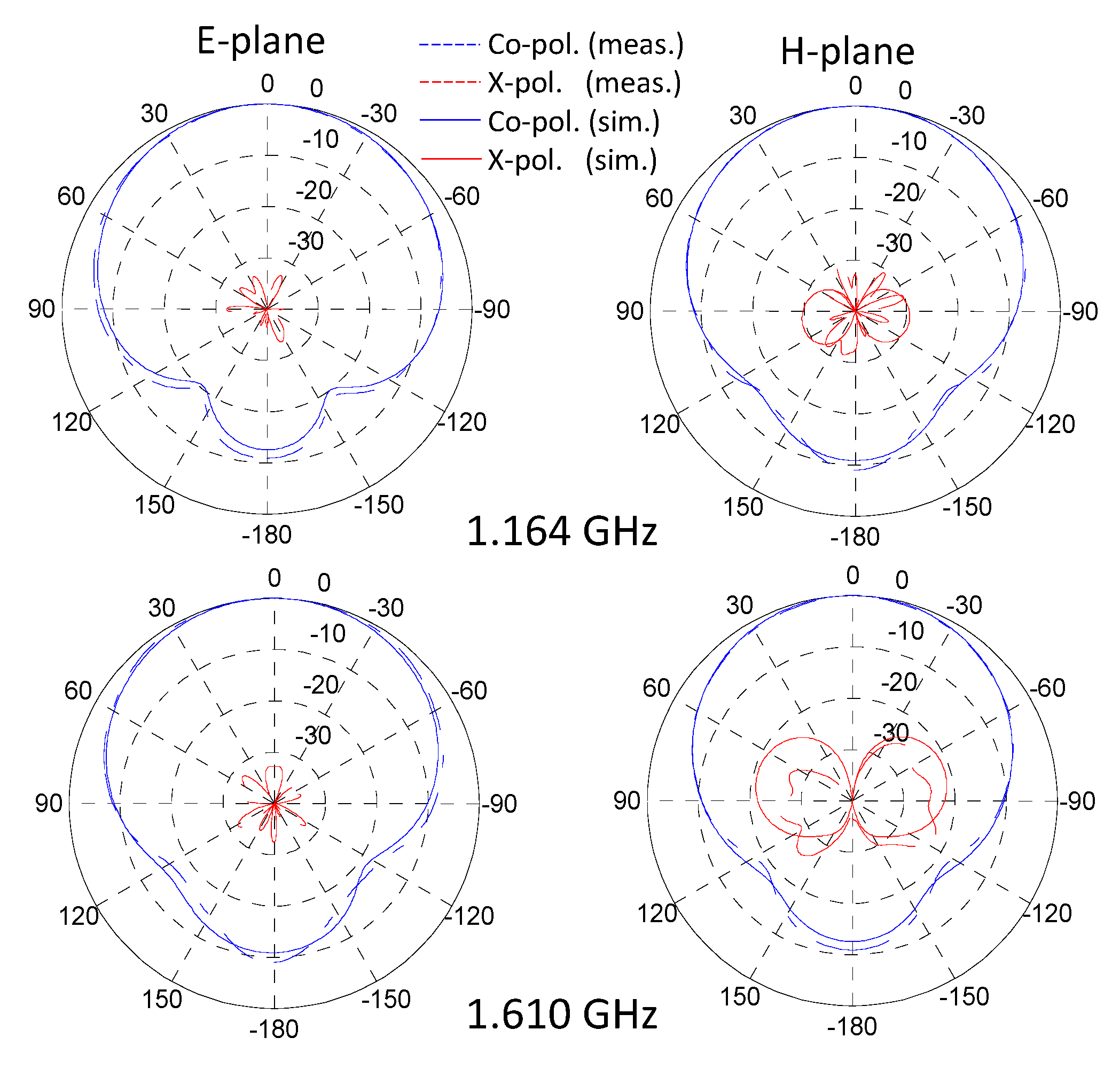
5. Conclusions
Author Contributions
Funding
Institutional Review Board Statement
Informed Consent Statement
Data Availability Statement
Conflicts of Interest
References
- Pathak, V.; Thornwall, S.; Krier, M.; Rowson, S.; Poilasne, G.; Desclos, L. Mobile handset system performance comparison of a linearly polarized GPS internal antenna with a circularly polarized antenna. In Proceedings of the IEEE Antennas and Propagation Society International Symposium. Digest. Held in Conjunction with: USNC/CNC/URSI North American Radio Sci. Meeting (Cat. No.03CH37450), Columbus, OH, USA, 22–27 June 2003; Volume 3, pp. 666–669. [Google Scholar] [CrossRef]
- Serra, A.A.; Nepa, P.; Manara, G.; Massini, R. A Low-Profile Linearly Polarized 3D PIFA for Handheld GPS Terminals. IEEE Trans. Antennas Propag. 2010, 58, 1060–1066. [Google Scholar] [CrossRef]
- Luk, K.-M.; Wong, H. A New Wideband Unidirectional Antenna Element. Int. J. Microw. Opt. Technol. 2006, 1, 35–44. [Google Scholar]
- An, W.X.; Lau, K.L.; Li, S.F.; Xue, Q. Wideband E-shaped dipole antenna with staircase-shaped feeding strip. Electron. Lett. 2010, 46, 1583–1584. [Google Scholar] [CrossRef]
- Tao, J.; Feng, Q.; Liu, T. Dual-Wideband Magnetoelectric Dipole Antenna with Director Loaded. IEEE Antennas Wirel. Propag. Lett. 2018, 17, 1885–1889. [Google Scholar] [CrossRef]
- Chang, L.; Zhang, J.-Q.; Chen, L.-L.; Li, B.-M. Bandwidth-Enhanced Cavity-Backed Magneto-Electric Dipole Antenna. IEEE Access 2018, 6, 62482–62489. [Google Scholar] [CrossRef]
- Zeng, J.; Luk, K.-M. A Simple Wideband Magnetoelectric Dipole Antenna with a Defected Ground Structure. Antennas Wirel. Propag. Lett. 2018, 17, 1497–1500. [Google Scholar] [CrossRef]
- Ge, L.; Luk, K.M. A Magneto-Electric Dipole Antenna with Low-Profile and Simple Structure. Antennas Wirel. Propag. Lett. 2013, 12, 140–142. [Google Scholar] [CrossRef]
- Ding, C.; Luk, K.-M. Low-Profile Magneto-Electric Dipole Antenna. Antennas Wirel. Propag. Lett. 2016, 15, 1642–1644. [Google Scholar] [CrossRef]
- Li, M.; Luk, K.-M.; Ge, L.; Zhang, K. Miniaturization of Magnetoelectric Dipole Antenna by Using Metamaterial Loading. IEEE Trans. Antennas Propag. 2016, 64, 4914–4918. [Google Scholar] [CrossRef]
- Zavosh, F.; Aberle, J.T. Improving the performance of microstrip-patch antennas. IEEE Antennas Propag. Mag. 1996, 38, 7–12. [Google Scholar] [CrossRef]
- Lalbakhsh, A.; Afzal, M.U.; Esselle, K.P.; Smith, S.L.; Zeb, B.A. Single-Dielectric Wideband Partially Reflecting Surface With Variable Reflection Components for Realization of a Compact High-Gain Resonant Cavity Antenna. IEEE Trans. Antennas Propag. 2019, 67, 1916–1921. [Google Scholar] [CrossRef]
- Martinis, M.; Mahdjoubi, K.; Sauleau, R.; Collardey, S.; Bernard, L. Bandwidth Behavior and Improvement of Miniature Cavity Antennas With Broadside Radiation Pattern Using a Metasurface. IEEE Trans. Antennas Propag. 2015, 63, 1899–1908. [Google Scholar] [CrossRef]
- Saghati, A.P.; Saghati, A.P.; Entesari, K. An Ultra-Miniature SIW Cavity-Backed Slot Antenna. IEEE Antennas Wirel. Propag. Lett. 2017, 16, 313–316. [Google Scholar] [CrossRef]
- Ge, L.; Luk, K.M. A Low-Profile Magneto-Electric Dipole Antenna. IEEE Trans. Antennas Propagat. 2012, 60, 1684–1689. [Google Scholar] [CrossRef]
- Neetu; Pandey, G.P.; Tiwari, V.N.; Marwah, S.S. A novel ultra-wide band magneto-electric dipole antenna with cavity reflector. PIER C 2016, 63, 143–152. [Google Scholar] [CrossRef][Green Version]
- Li, J.; Zhang, A.; Liu, J.; Liu, Q.H. Cavity-backed wideband magneto-electric antenna for through-the-wall imaging radar applications. In Proceedings of the 2016 IEEE Radar Conference (RadarConf), Philadelphia, PA, USA, 2–6 May 2016; pp. 1–3. [Google Scholar] [CrossRef]
- De Cos, M.E.; Las-Heras, F. Polypropylene-Based Dual-Band CPW-Fed Monopole Antenna. IEEE Antennas Propag. Mag. 2013, 55, 264–273. [Google Scholar] [CrossRef]
- Ansys HFSS Home Page. Available online: https://www.ansys.com/fr-fr/products/electronics/ansys-hfss (accessed on 15 February 2021).
- Lalbakhsh, A.; Alizadeh, S.M.; Ghaderi, A.; Golestanifar, A.; Mohamadzade, B.; Jamshidi, M.; Mandal, K.; Mohyuddin, W. A Design of a Dual-Band Bandpass Filter Based on Modal Analysis for Modern Communication Systems. Electronics 2020, 9, 1770. [Google Scholar] [CrossRef]

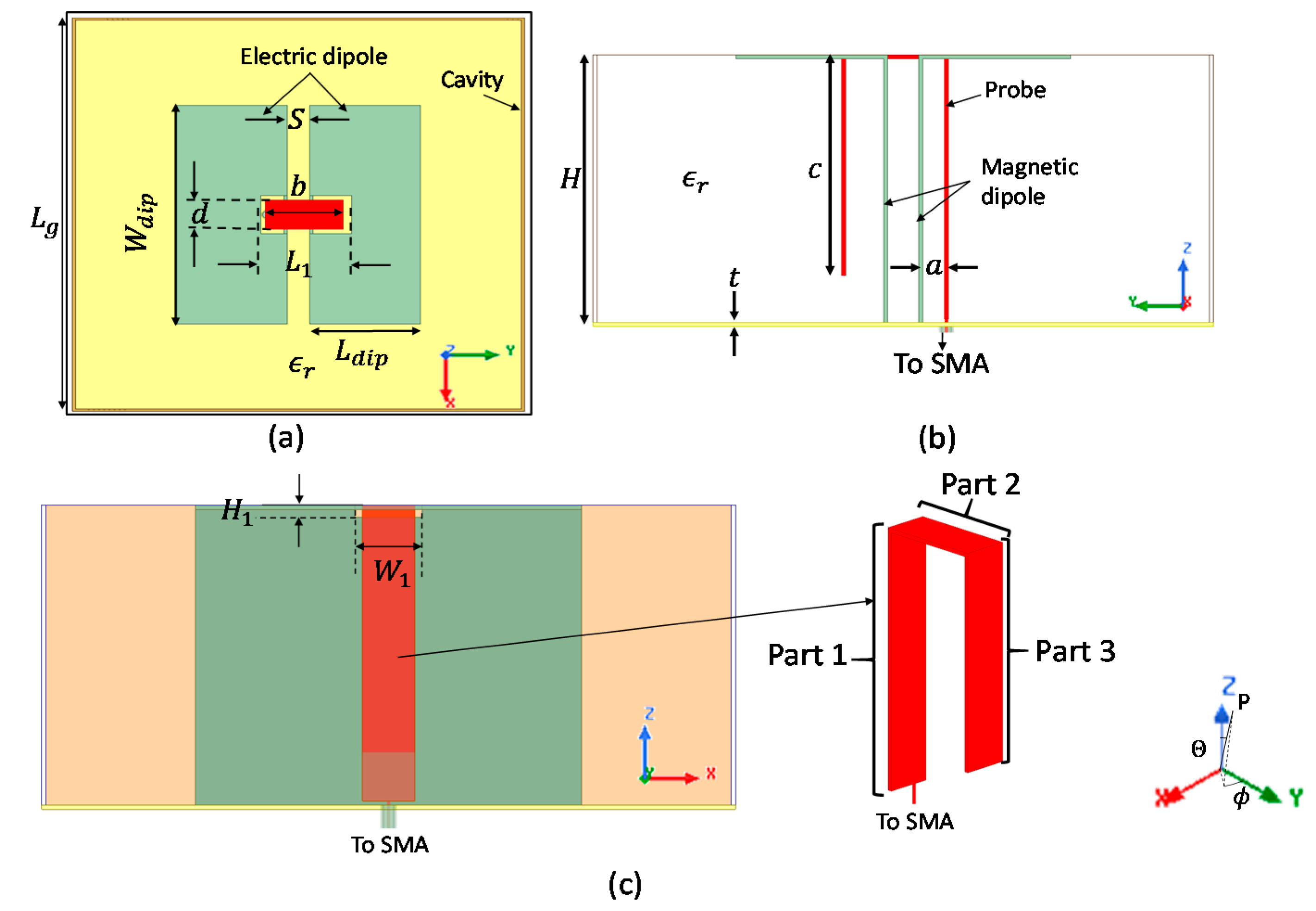
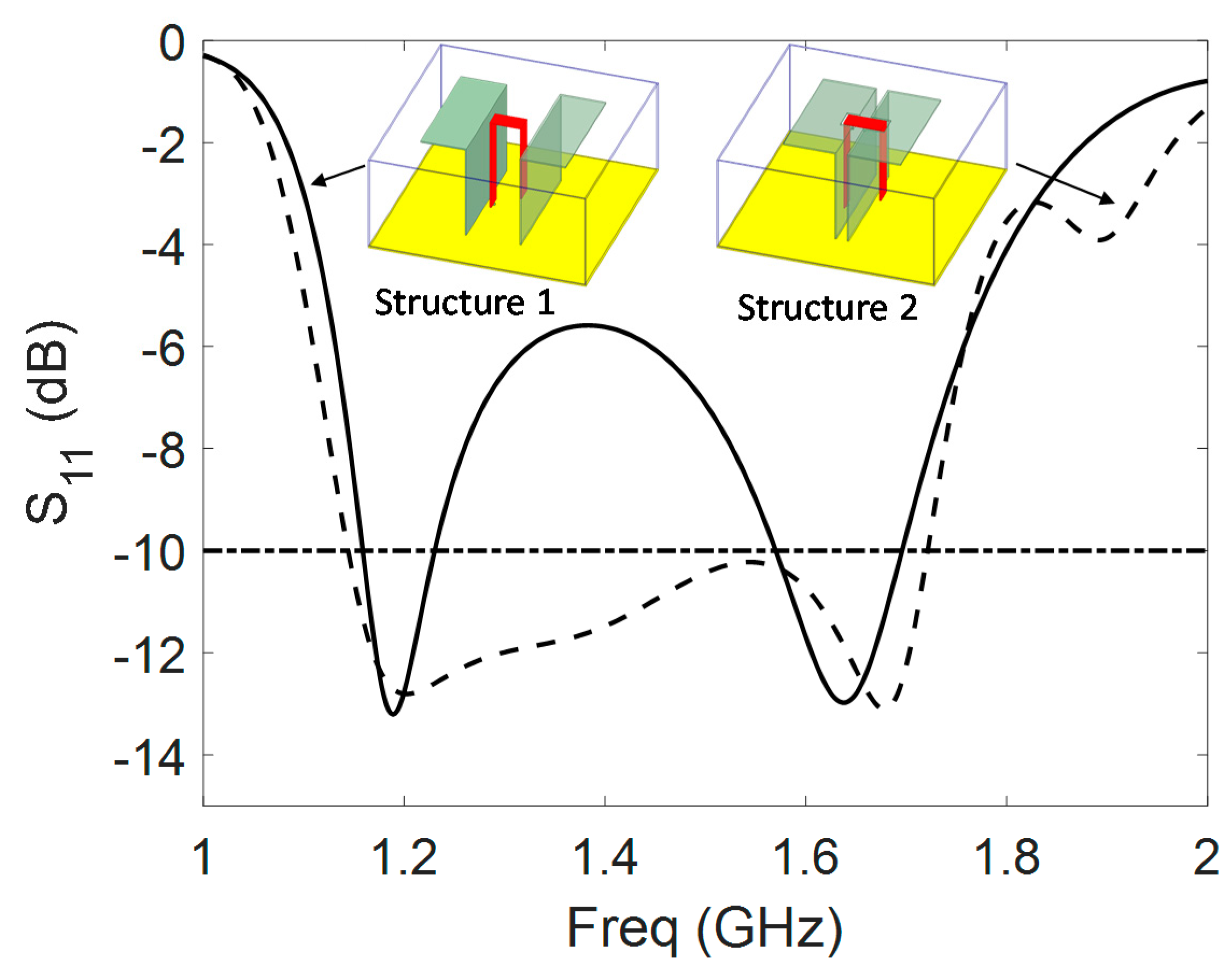
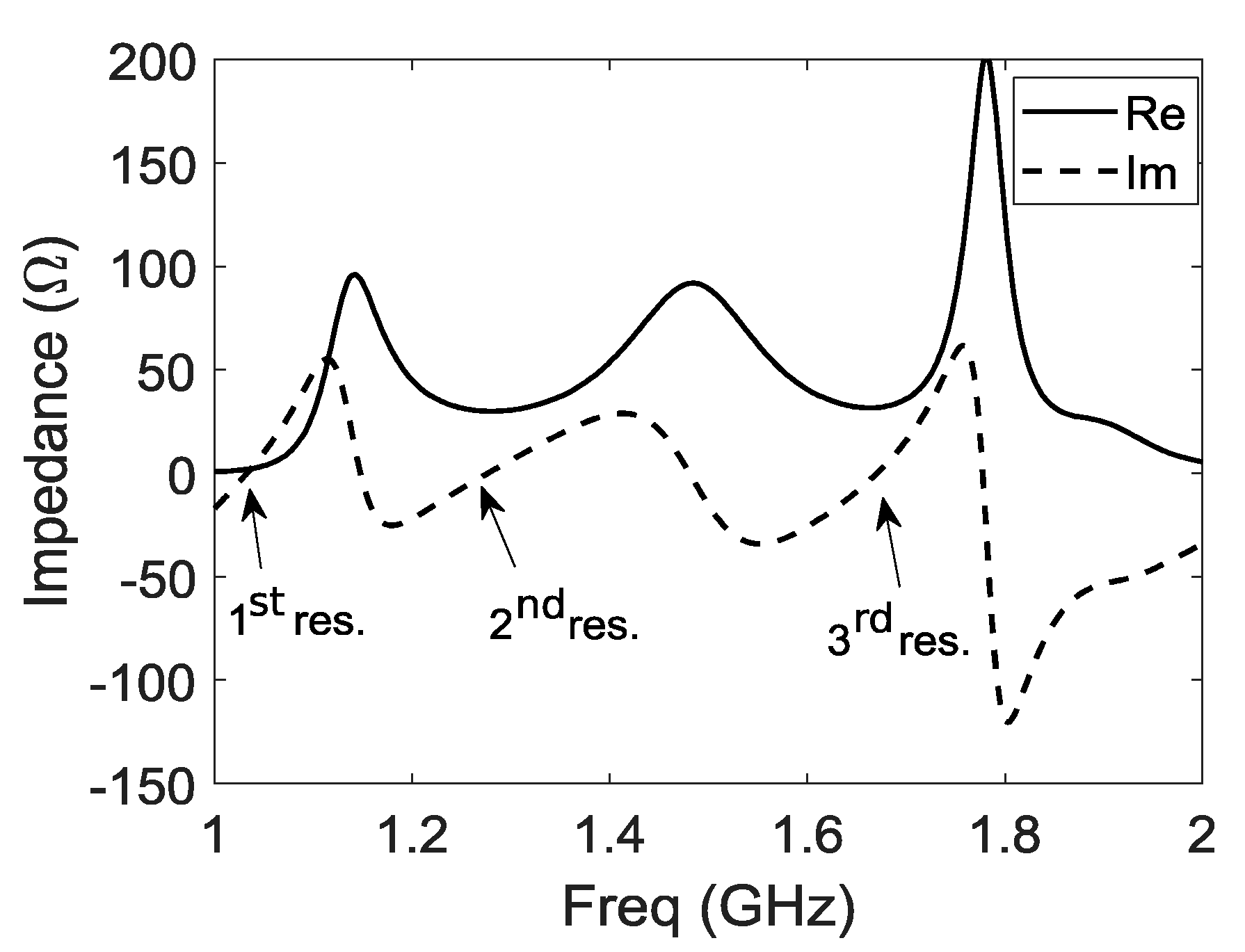
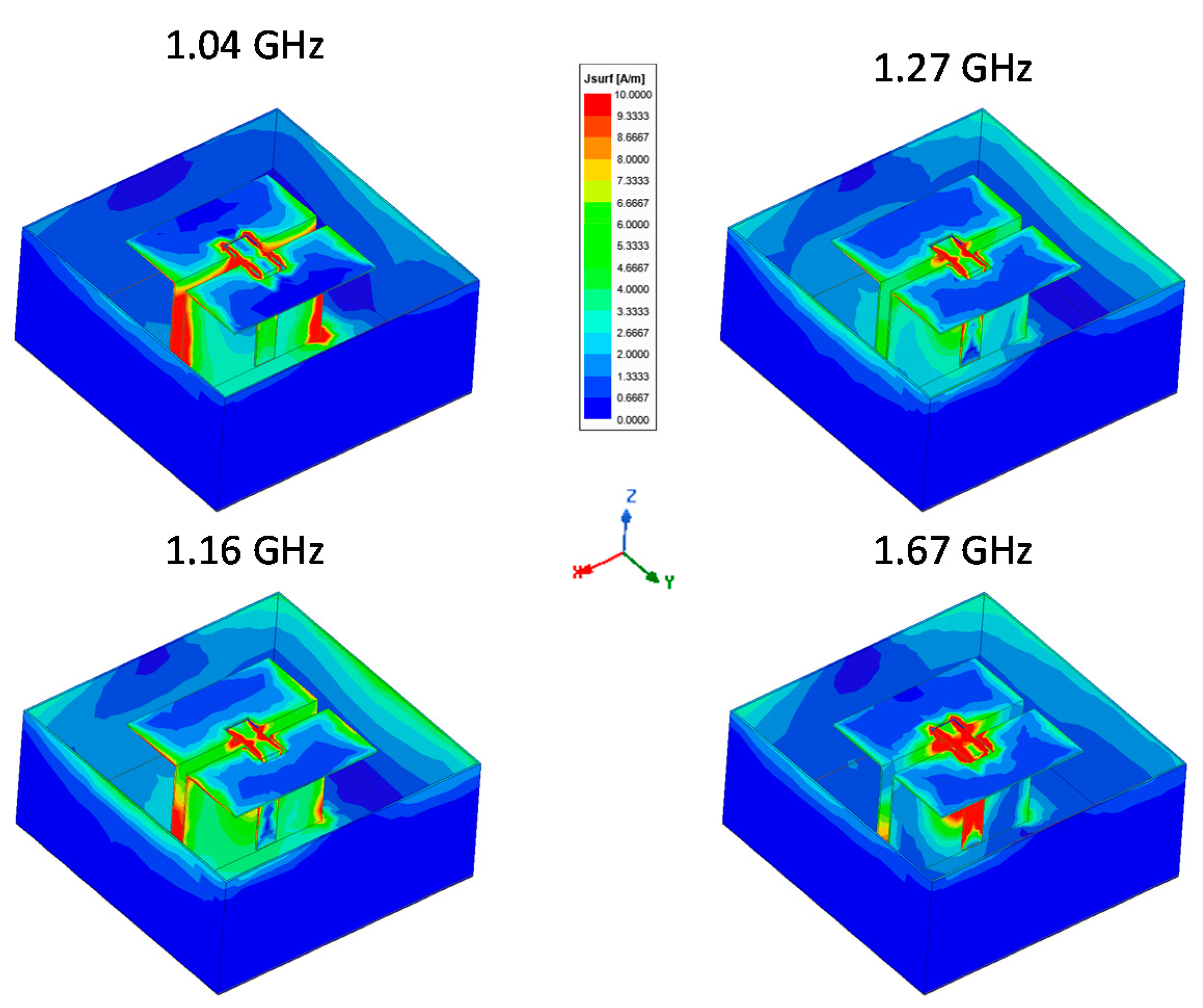
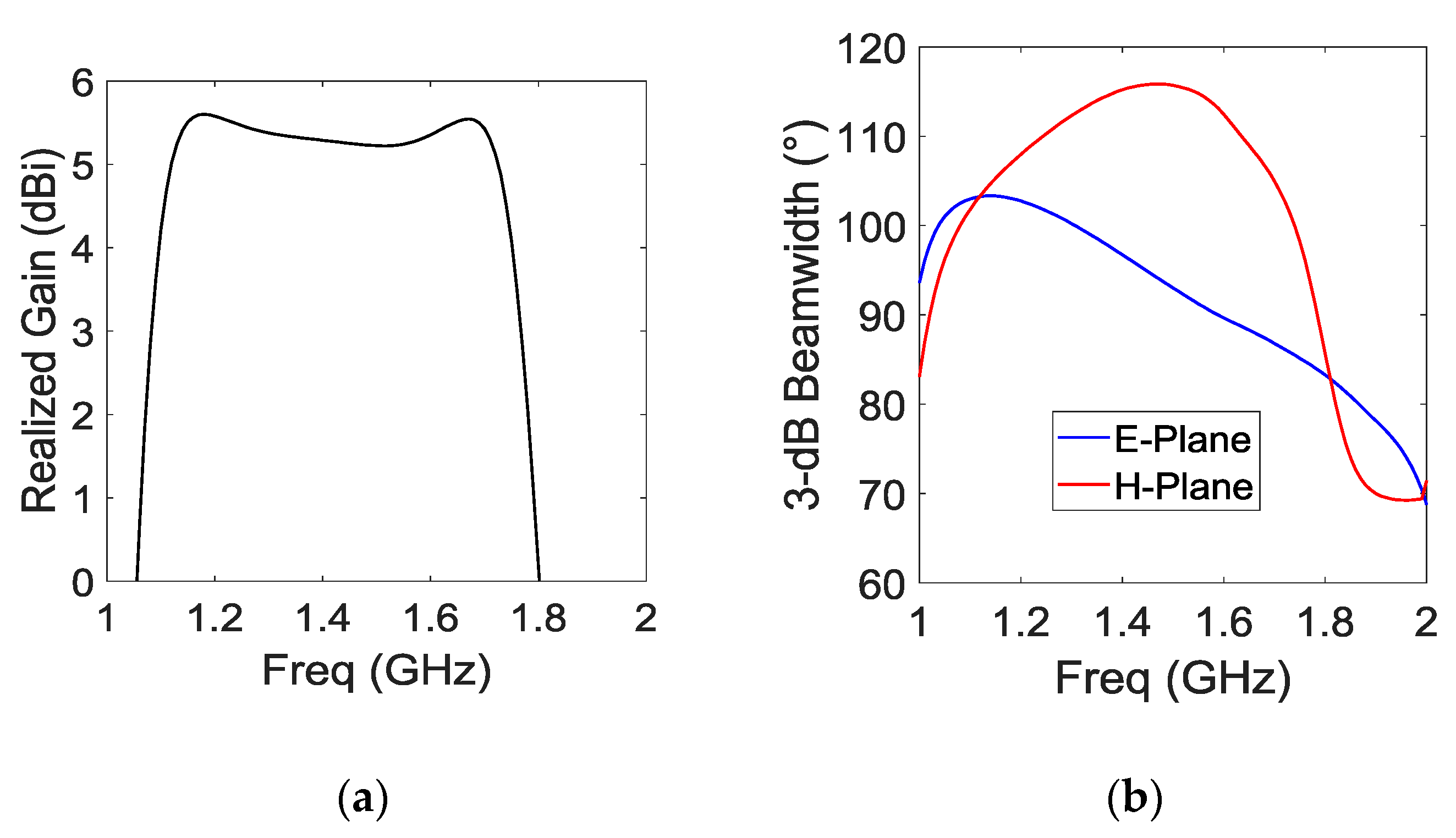
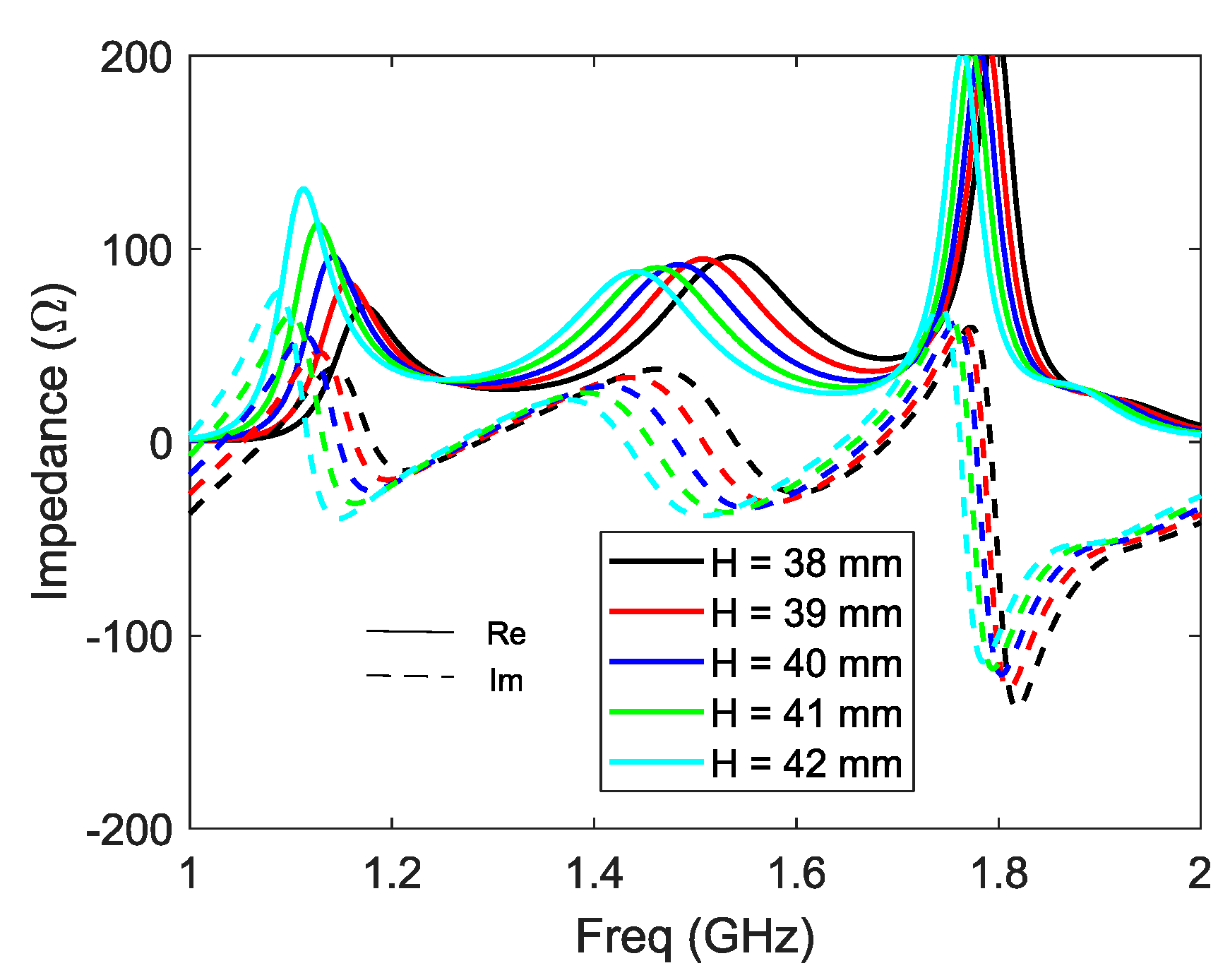
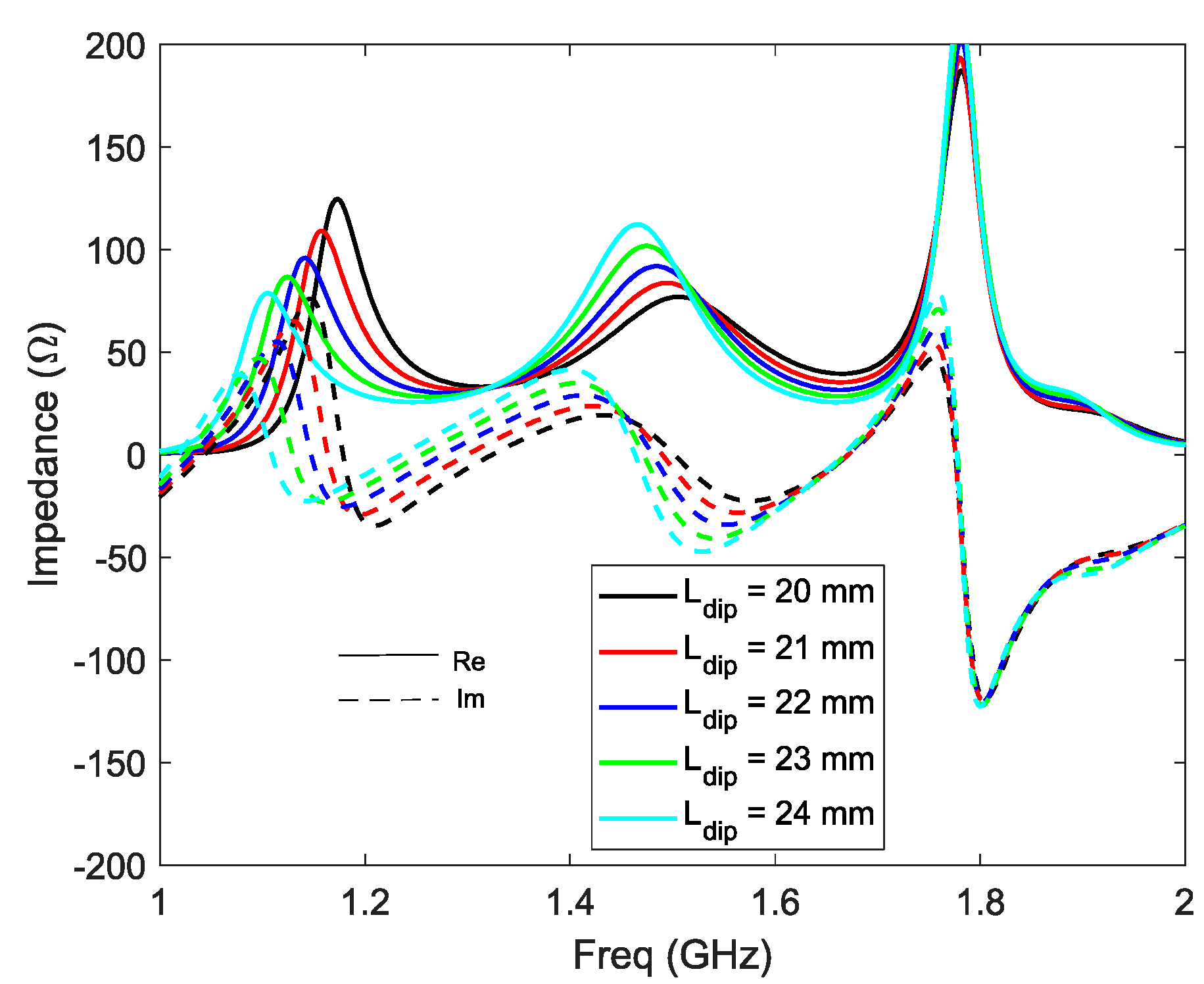
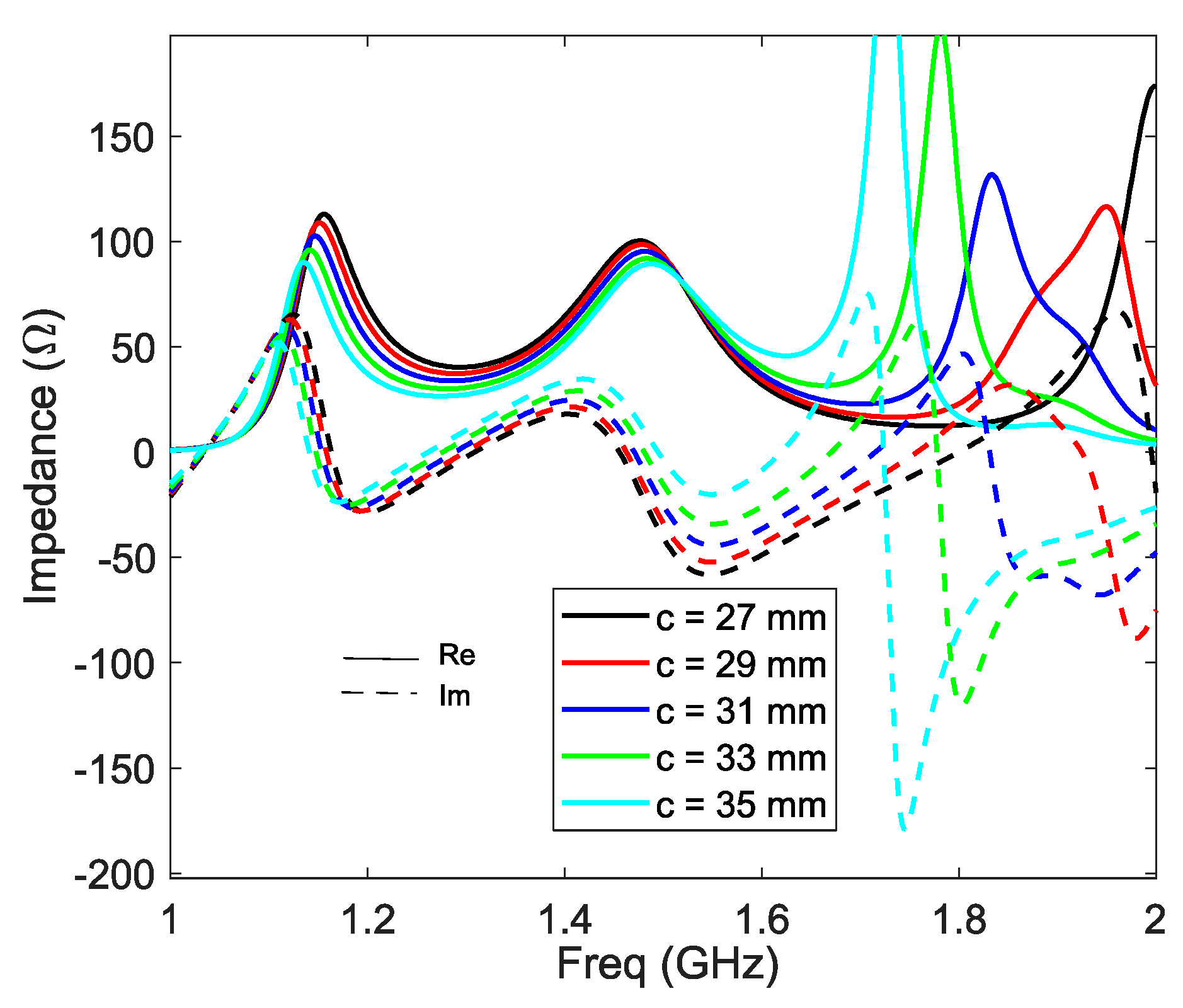

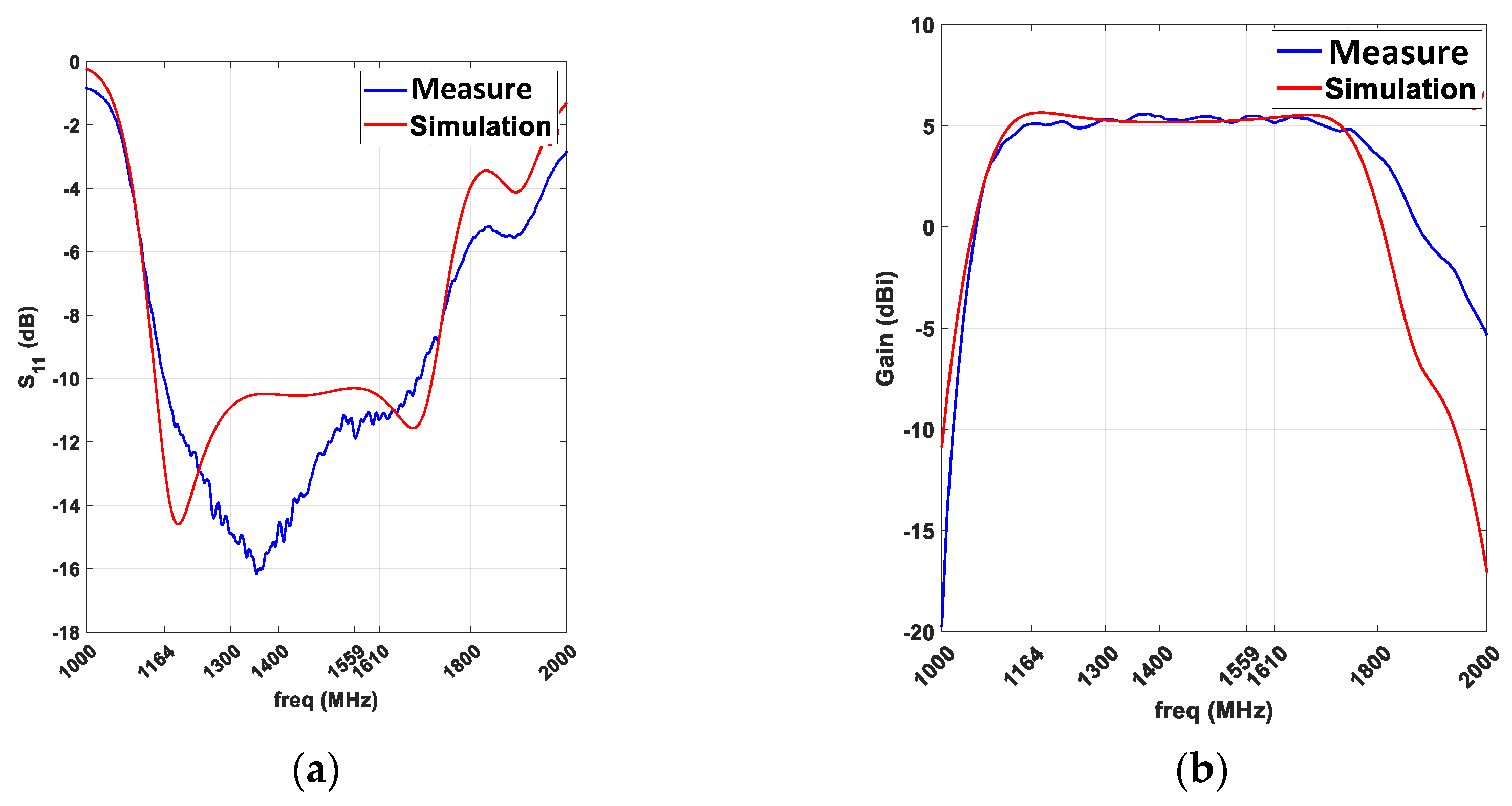
| Structures | 1 | 2 | Structures | 1 | 2 | ||
|---|---|---|---|---|---|---|---|
| Parameters | Value (mm) | Parameters | Value (mm) | ||||
| 90 | 3 | −4 | |||||
| 40 | 12 | 15.5 | |||||
| 19 | 22 | 33 | |||||
| 50 | 6.75 | ||||||
| 22 | 4.5 | 0.6 | |||||
| - | 8.75 | - | 17.5 | ||||
| - | 1.6 | - | - | - | |||
| Param. | Var. | 1st res. | 2nd res. | 3rd res. | |||
|---|---|---|---|---|---|---|---|
| - | - | Freq. | Ampl | Freq. | Ampl | Freq. | Ampl |
 | + | + | + | ||||
 | ++ | = | = | = | |||
 | = | + | |||||
 | = | ++ | = | ++ | |||
| a |  | = | ++ | = | = | = | |
| b |  | = | = | ++ | |||
| c |  | = | = | = | = | ||
| 3 dB Beamwidth | FTBR | X-Pol | Real. Gain | |
|---|---|---|---|---|
| Sim. | 92° | >10.9 dBi | 54 dB | 5.2 |
| Meas. | 89° | >9.1 dBi | 32.8 dB | 5.1 |
| Reference. | Dimensions (λc) | Volume Compared to [4] | Impedance Bandwidth | Minimum HPBW | Max X-Pol Level |
|---|---|---|---|---|---|
| 4 | 0.93 × 1.22 × 0.36 | 100% | 88% | 55° | −20 dB |
| 13 | 0.967 × 0.967 × 0.173 | 39.6% | 54.8% | 30° | −20 dB |
| 14 | 1.6 × 1.18 × 0.34 | 157.2% | 68.8% | 60° | −30 dB |
| 15 | 0.86 × 0.76 × 0.23 | 36.8% | 76% | 60° | n/a |
| This work | 0.41 × 0.41 × 0.18 | 7.4% | 40.5% | 89° | −32.8 dB |
Publisher’s Note: MDPI stays neutral with regard to jurisdictional claims in published maps and institutional affiliations. |
© 2021 by the authors. Licensee MDPI, Basel, Switzerland. This article is an open access article distributed under the terms and conditions of the Creative Commons Attribution (CC BY) license (https://creativecommons.org/licenses/by/4.0/).
Share and Cite
Causse, A.; Rodriguez, K.; Bernard, L.; Sharaiha, A.; Collardey, S. Compact Bandwidth Enhanced Cavity-Backed Magneto-Electric Dipole Antenna with Outer Γ-Shaped Probe for GNSS Bands. Sensors 2021, 21, 3599. https://doi.org/10.3390/s21113599
Causse A, Rodriguez K, Bernard L, Sharaiha A, Collardey S. Compact Bandwidth Enhanced Cavity-Backed Magneto-Electric Dipole Antenna with Outer Γ-Shaped Probe for GNSS Bands. Sensors. 2021; 21(11):3599. https://doi.org/10.3390/s21113599
Chicago/Turabian StyleCausse, Alexandre, Kevin Rodriguez, Loïc Bernard, Ala Sharaiha, and Sylvain Collardey. 2021. "Compact Bandwidth Enhanced Cavity-Backed Magneto-Electric Dipole Antenna with Outer Γ-Shaped Probe for GNSS Bands" Sensors 21, no. 11: 3599. https://doi.org/10.3390/s21113599
APA StyleCausse, A., Rodriguez, K., Bernard, L., Sharaiha, A., & Collardey, S. (2021). Compact Bandwidth Enhanced Cavity-Backed Magneto-Electric Dipole Antenna with Outer Γ-Shaped Probe for GNSS Bands. Sensors, 21(11), 3599. https://doi.org/10.3390/s21113599







